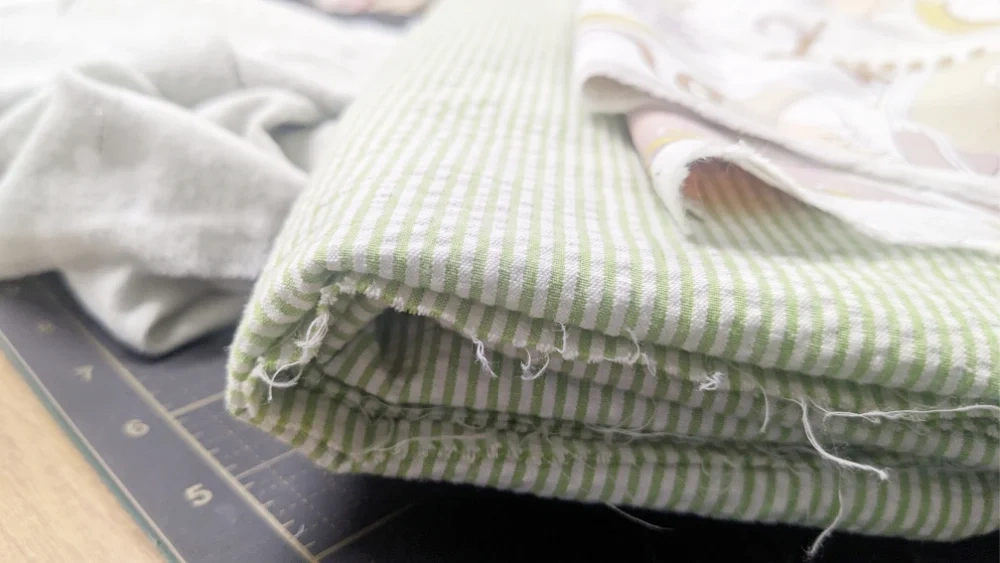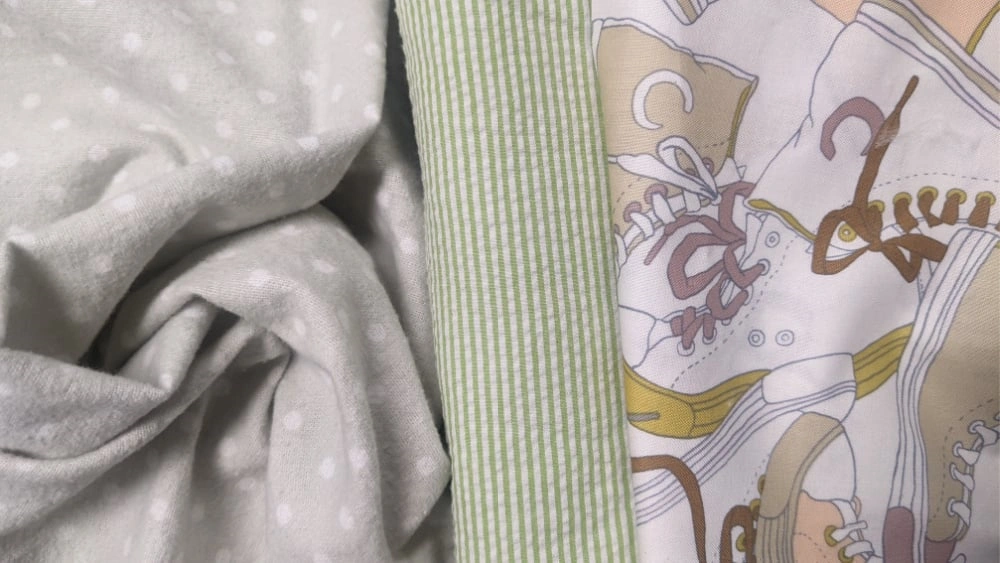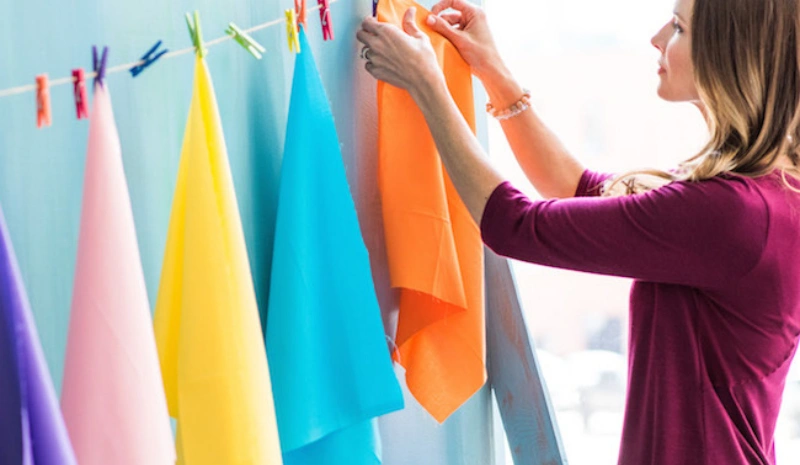Yes, you can mix flannel and cotton fabric in a quilt top, but you’ll want to watch out for a few things. Flannel shrinks more than cotton fabric, so prewashing is key to avoiding a wonky quilt project.
You might notice flannel feels thicker, which can affect your seams. Some quilters find that prewashing both fabrics can lead to fraying or color fading, so handle edges gently.
With a bit of prep, you can create cozy, textured quilts that stand out. Fanda Fabrics offers both cotton and flannel fabric options to help you get started!
Key Takeaways
Always prewash both flannel and cotton fabrics to prevent shrinkage and keep your quilt looking great after washing.
Use a consistent 1/4 inch or wider seam allowance and press seams carefully to handle the thickness difference between flannel and cotton.
Choose fabrics with similar weight and drape to avoid lumps and keep your quilt smooth and even.
Use a walking foot and pin fabrics every 6-8 inches to prevent shifting and ensure straight seams when sewing mixed fabrics.
Mixing flannel and cotton adds warmth, texture, and durability, making your quilt cozy and perfect for chilly seasons.
Can flannel and cotton fabric be mixed in quilt top?
Mixing Cotton and Flannel: What to Know

You might wonder, can flannel and cotton fabric be mixed in a quilt top? The answer is yes, and many quilters love the results. When you mix fiber types like flannel and cotton, you get a quilt that feels both soft and sturdy. Flannel brings extra warmth and a cozy texture, while cotton keeps things light and easy to sew.
Before you start mixing cotton and flannel, you should know a few things:
Flannel is thicker and softer than regular cotton. It can shrink more, especially after the first wash.
Cotton is more stable and holds its shape well. It’s easier to cut and piece together.
Mixing cottons and flannel in a quilt means you need to adjust your sewing technique. Use a precise 1/4 inch seam allowance and press seams with an up-and-down motion, not side-to-side. This helps keep your quilt project flat and neat.
Experts suggest prewashing flannel multiple times in hot water to reduce shrinkage. You can prewash cotton too, but flannel needs it more.
Choose 100% cotton flannel and quilting cotton for the best results. This helps avoid surprises when you wash your finished quilt.
When you mix fiber types, pick fabrics with similar weights and drape. This keeps your quilt from feeling lumpy or uneven.
Use polyester or fine cotton thread for strength and flexibility. Heavy thread can make your quilt stiff.
Tip: Layer lighter cotton on top of heavier flannel when sewing. This helps prevent shifting and bunching.
Fanda Fabrics offers both high-quality cotton quilting fabric and soft flannel fabric, so you can find the perfect match for your next quilt.
Benefits of Mixing Fabrics in Quilts

Mixing cotton and flannel in your quilt top opens up a world of creative options. Here’s why you might want to try it:
You add texture and dimension to your quilt. Flannel’s brushed surface feels different from smooth cotton, making each block stand out.
The combination of flannel and cotton gives you the best of both worlds—cotton’s durability and flannel’s warmth.
Quilts made with both fabrics are perfect for chilly nights or as gifts for kids. They feel extra snuggly and inviting.
Mixing fabrics in quilts lets you experiment with color, pattern, and feel. You can create a unique look that’s all your own.
Many quilters find that when they mix flannel and cotton, their quilts become favorites for fall and winter.
Mixing fiber types isn’t just about looks. It’s about comfort, too. Flannel keeps you warm, while cotton makes the quilt easy to care for and long-lasting. You get a quilt that’s both practical and beautiful.
If you want to try mixing cotton and flannel, Fanda Fabrics has a wide selection of both. You can choose from solid colors, prints, and even custom options to make your quilt truly special.
Pre-washing and Shrinkage

When you mix fiber types like flannel and cotton in your quilt top, pre-washing is one of the most important steps you can take. Flannel shrinks more than regular cotton, sometimes up to 5%, while cotton usually shrinks around 3%.
If you skip pre-washing, your quilt might end up puckered or distorted after its first wash. Pre-washing also removes extra dye and chemicals, which helps prevent color bleeding and skin irritation.
Pre-washing Steps
You want your quilt to look great and last for years, so let’s talk about how to pre-wash both flannel and cotton fabrics:
Sort your fabrics by color. Wash darks and lights separately to avoid dye transfer.
Use cold or lukewarm water with a gentle detergent. Add a color catcher if you’re worried about bleeding.
For flannel, wash and dry it at least twice on hot settings. This helps get most of the shrinkage out before you start sewing. Flannel can lose up to a quarter-yard after washing, so don’t be surprised if it looks smaller.
For cotton, one wash and dry cycle is usually enough. Cotton quilting fabrics from Fanda Fabrics are easy to care for and pre-wash, so you’ll have fewer surprises.
Small pieces? Place them in a mesh laundry bag to prevent tangling and fraying.
After washing, trim any loose threads and press your fabrics flat. You can use a little starch on flannel to bring back some crispness.
Tip: Pre-washing all your fabrics means your quilt will keep its shape and color, even after many washes.
Managing Shrinkage Differences
Mixing fiber types in one quilt means you need to plan for different shrinkage rates. Flannel keeps shrinking a bit with each wash until it stabilizes, while cotton settles faster. To manage this, always pre-wash both fabrics before you cut or sew. If you use batting, pre-wash that too, especially if it’s cotton, since it can shrink 3-5%.
Here are some extra considerations when mixing fiber types:
Pre-wash flannel multiple times to get most of the shrinkage out.
Use wider seam allowances and shorter stitch lengths to keep seams strong, since flannel frays more.
Try bias binding for edges, which handles shrinkage better over time.
Mix fiber types with confidence by following these steps. Your quilt will look beautiful and stay cozy for years.
Thickness and Seam Allowances
Handling Fabric Thickness
Mixing flannel and cotton in your quilt top brings a cozy feel, but you’ll notice flannel is thicker and softer than cotton. This thickness comes from flannel’s loose weave and napped surface, which makes it warmer and fuzzier.
Cotton quilting fabric, like the ones in Fanda Fabrics’ quilting collection, is mid-weight and holds its shape well. When you cut flannel, it can shift more than cotton, so use fewer layers at a time. Rotary cutting works best if you slow down and pin your flannel pieces before slicing.
You want your quilt blocks to lie flat. Thicker flannel can add bulk, especially where seams meet. Pressing seams open helps reduce bulk and keeps your quilt smooth. Pre-starch and press your flannel before cutting to prevent distortion.
If you use both flannel and cotton, try a walking foot on your sewing machine. This tool helps feed both fabrics evenly, so you won’t get puckering or slipping.
Tip: Pin your flannel and cotton pieces every 6-8 inches. This keeps layers from shifting and helps you sew straight seams.
Adjusting Seam Allowances
Seam allowances matter a lot when you mix flannel and cotton. Flannel tends to fray more, so you should avoid a scant 1/4 inch seam. Stick to a standard 1/4 inch or even bump up to 1/2 inch for extra durability.
Consistency is key. Use the same seam allowance for both flannel and cotton throughout your quilt. If you switch seam widths, your blocks might not line up.
Here are some quick tips for seam allowance success:
Finish raw edges with a zigzag stitch or serger, especially on flannel.
Use a magnetic seam guide or a quarter-inch quilting foot to keep seams straight.
Press seams open when you notice extra bulk, especially with flannel.
Always check your seam width before starting a new project.
Fanda Fabrics’ solid color quilt fabric gives you reliable quality, so your seams stay strong and your quilt looks professional. Mixing flannel and cotton can be easy if you plan and use the right tools.
Sewing Tips for Mixing Fabrics in Quilts
Needles, Thread, and Machine Settings
Choosing the right needle and thread makes a big difference when you sew flannel and cotton together. Flannel is thicker and softer, so you want a needle that can handle it without bending. For most cotton quilting fabrics, a size 9 to 11 quilting needle works well.
When you add flannel, switch to a size 12 or even a 90/14 needle if your flannel is extra thick. Ballpoint needles help with loosely woven flannel, while sharp needles are best for tightly woven cotton.
Pair your needle with a 50-weight cotton thread. This thread weight balances strength and smooth stitching for both fabrics. If you use a thicker thread, make sure your needle is large enough so the thread glides through easily.
Adjust your machine’s tension if you notice skipped stitches or puckering. Test on a scrap before you start your quilt blocks.
Tip: Use a walking foot on your sewing machine. It helps feed both flannel and cotton evenly, so your seams stay straight and flat.
Preventing Stretch and Fraying
Mixing flannel and cotton means you need to watch for stretching and fraying. Here are some easy ways to keep your quilt looking sharp:
Pre-wash both fabrics to shrink and stabilize them.
Handle your pieces gently to avoid stretching the edges.
Finish raw edges with a zigzag stitch or serger, especially on flannel.
Use high-quality quilting thread for strong seams.
Check your machine’s tension and needle often to prevent fabric damage.
Reinforce seams that look weak or start to fray.
If you want extra support, try using a lightweight or medium-weight interfacing. Fusible interfacing is quick and easy, but sew-in interfacing works better for heat-sensitive flannel. Always match the interfacing weight to your fabric for the best drape.
Fabric Type | Stabilizer Type | Best Use |
|---|---|---|
Cotton | Lightweight interfacing | Adds structure, keeps soft |
Flannel | Medium-weight interfacing | Prevents stretching, fraying |
You can also layer cotton fabric as a DIY stabilizer. Test on scraps to see what feels right.
For even more support, check out Fanda Fabrics’ double-sided quilted fabric and cotton quilt batting. These products add stability and warmth, making your mixed-fabric quilt even cozier and easier to sew.
Pros and Cons of Mixing Different Types of Quilt Fabric
Advantages of Mixing Flannel and Cotton
When you start mixing different types of quilt fabric, you open up a world of creative possibilities. Flannel and cotton together bring out the best in each other. Here’s what you’ll love about this combo:
Flannel adds warmth and coziness to your quilt, making it perfect for chilly nights or snuggling on the couch.
Cotton gives your quilt structure and durability. It helps your quilt blocks stay crisp and prevents distortion.
The softness of flannel feels amazing, while cotton’s smooth surface stands up to repeated washing.
Mixing fabric types lets you play with texture. Flannel’s fuzzy finish creates a unique look and feel, especially after a few washes.
Flannel frays easily, which can give your quilt those signature fluffy, ragged edges that add visual interest.
When you use fabrics of similar weight, like flannel and cotton, your quilt stays even and comfortable.
The combination of flannel and cotton results in cozy quilts that are both beautiful and long-lasting.
Tip: Prewash both fabrics before you start. This step helps prevent uneven shrinkage and keeps your quilt looking great for years.
Challenges to Consider
Mixing different types of quilt fabric does come with a few challenges. You’ll want to keep these in mind as you plan your project:
Flannel is heavier than regular cotton, so you may need to adjust your sewing machine settings.
Some cotton fabrics have a loose weave, which can stretch or fray more easily when paired with flannel.
Mixing fabric types can sometimes lead to unpredictable results during washing, like puckering or uneven shrinkage.
If you want a quilt that will be washed often, sticking with 100% cotton might be easier. However, if your quilt is for display or light use, mixing flannel and cotton can give you a special look and feel.
Every quilt has its personality. The pros and cons of mixing cotton and flannel depend on your goals and how you plan to use your quilt. Don’t be afraid to experiment! Fanda Fabrics offers a wide selection of both flannel and cotton, so you can create cozy quilts that reflect your style and creativity.
Conclusion
Mixing flannel and cotton in your quilt top can make your quilt project unique and cozy. You just need a little planning. Always prewash your fabrics, test seam allowances, and use extra pins for thick spots.
Try fabric swatches to check feel and wash behavior before you start your quilt project. Explore Fanda Fabrics for a wide range of quilting fabrics. You can create something special, no matter your skill level!
FAQ
Can I use flannel and cotton together in a baby rag quilt?
Yes, you can mix flannel and cotton in a baby rag quilt. Flannel gives you that soft, fuzzy texture, while cotton adds durability. Just remember to prewash both fabrics so your quilt stays even and cozy after washing.
Will my quilt shrink if I mix flannel and cotton?
You will see some shrinkage, especially with flannel. Prewash both fabrics before you sew. This step helps your quilt keep its shape and prevents puckering after you wash it for the first time.
How do I stop my quilt from fraying too much?
Flannel frays more than cotton. You can use a zigzag stitch or a serger on the edges. If you want a rag look, let the edges fray on purpose. This style works great for a flannel baby rag quilt.
What needle should I use for sewing flannel and cotton?
Use a size 12 or 90/14 needle for flannel. For cotton, a size 11 works well. If you sew both together, start with the larger needle. Test on scraps first to make sure your stitches look good.
Do I need special batting when mixing these fabrics?
You do not need special batting. Cotton quilt batting works well with both flannel and cotton. It adds warmth and keeps your quilt soft. Fanda Fabrics offers high-quality batting that pairs perfectly with mixed-fabric quilts.
